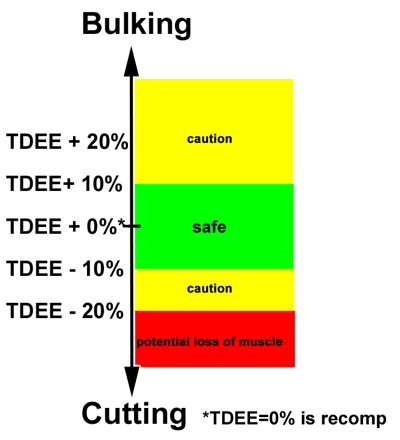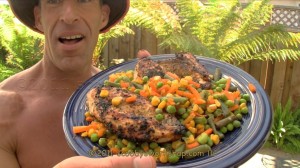Bodybuilding Nutrition Made Simple
A Top Down Approach
Many bodybuilders know they need to have “good nutrition” to build a great physique but they are not quite sure where to start as nutrition seems complicated and mysterious – its not! Bodybuilding nutrition is really quite simple if you use a top-down approach. A lot of the confusion people have is that they hear “you should do this” and “you should do that” only to find that all the advice seems to conflict and doesn’t seem to fit into a bigger picture. here I’m going to give you the bigger picture so YOU can put together your OWN nutritional plan to meet your goals.
A bodybuilders nutritional plan is very similar to a personal financial budget. Both are about making difficult choices and then sticking to the budget – in both cases, disaster strikes if you blow the budget. If you blow your financial budget, you end up over your head in 21% credit card debt. If you blow your nutritional budget you end up fat or weak.
In a financial plan you start with your income and then subtract out the nonnegotiable expenses like taxes and rent to find out how much spending money we have. For our nutritional plan we start with amount of calories we can eat per day, then subtract out the things we need for lean muscle growth then see how many cheat foods we can have. Lets look at how easy the top down approach to bodybuilding nutritional planning is.
How to make a bodybuilding nutritional plan
- Determine how many calories you need per day. This is the key starting point and it takes just two minutes. Use my calorie calculator to figure out how much energy your body needs every day, your TDEE (Total Daily Energy Expenditure). Lets take an example. A 25 year old 160 pound person who is 68″ tall and does 3-5 hours of cardio a week has a TDEE of 2721 calories per day according to my calorie calculator.
- Decide on your caloric goal. Are you going to be cutting, bulking, or recompositioning? If you are cutting then your daily caloric goal will be less than the amount of energy your body needs to maintain weight (your TDEE). If you are bulking (adding weight) then your daily caloric budget will be greater than your TDEE. If you are “recompositioning”, or gaining muscle and losing fat at the same time, then your caloric budget will be exactly your TDEE.

Again, lets continue this example. The person in step 1 wants to cut so they will be at a 20% caloric deficit: 2721 calories – 20% = 2176 calories per day. That is their daily caloric target. - Decide on your macros. “Macro” is short for “macronutrient ratios” and in bodybuilding it means one of three nutritional pigeonholes: protein, carbohydrate and fat. So what you have to decide is what percent of your caloric intake do you want from protein, carbs, and fat. Note that these percentages are calculated by calories, not weight. Carbs and protein are 4 calories per gram whereas fat is 9 calories per gram. Lets now look a few common macros:
- 40% protein/40% carb/20% fat (probably the most common)
- 40% protein/50% carb/10% fat (used to be more common, now out of favor)
- 50% protein/10% carb/40% fat (low carb diets)
In my opinion its a bad idea to just set the protein to a percentage value. Its a much better idea to set protein consumption based upon bodyweight. To maximize muscle gain, the recommended amount of protein is 1g protein per pound of bodyweight per day. This means a 200 pound person consumes 200g protein per day. So what percent is that? It depends! If you don’t do any cardio at all you might need to go as high as 40% protein to get your 1g/pound. On the other hand, if that same person does gobs of cardio, they would have to drop it to about 20% to keep protein consumption at 1g/pound/day. Complicated? No, because my calorie calculator does this automatically for you! If you leave the “auto-set” box checked after step 8, the calculator will automatically set a protein percentage that results in 1g of protein per pound bodyweight per day and chooses other reasonable values for carbs and fat. If you don’t want to do any research to determine your macros then let my calculator auto-set it for you! OK, after step 2 here you know how many grams protein, carbohydrates, and fat you need each day.
- Calculate your budget. Now using those percentages, figure out how many grams of protein, carbohydrate, and fat you get per day. Below is a little math, no need to freak out though because my calorie calculator does all this for you – I’m just showing you how the thought process works here. If your daily caloric goal was 2176 calories as in the above example and your ratios 30/40/30 then daily you would get 653 calories of protein (2176cals * .4 = 653cals), 870 calories of carbs and 653 calories of fat. To figure out how many grams of protein/carb/fat you need to do a little division. Protein and carbs have 4 calories per gram and fat has 9 calories per gram. In this example, it works out to 163g or protein (653cals / 4cals/g = 163g protein), 217g of carbs, and 72g of fat per day. Again, don’t stress as my calorie calculator does this for you. So now you know your daily targets for how much protein, carbs and fat you can eat – this is your budget, your nutritional budget and you *must* live within this. Never again do you have to ask someone: “Is XYZ a good snack?”. You now have the knowledge to figure this out for yourself! If the food fits into your nutritional budget without blowing it, its a great snack!
- Are we done now?
What if this person decides to meet their macros above with a big scoop of white sugar for carbs, a stick of margarine for their fat, and a big bowl of isolated soy for their protein.
The above meets the macros but its obviously not healthy and it wont work well for gaining muscle. Lets look at what else is important other than the macros and total calories. There are a number of things that are very important to bodybuilding in addition to carbs, protein, and fat
- Vitamins and Anti-oxidants. Vitamins are important for building muscle. Yes, you can get vitamins from a pill but in my view, they are not nearly as good as what you get from natural sources. Many people tend to use multivitamins as an excuse not to eat vegetables, bad idea, there are other very important things in them besides vitamins – namely fiber. Fiber fills you up without calories so that you can cut without being hungry, not to mention the cancer protection. So start your daily nutritional plan by choosing 3 pieces of fruit and 4-6 cups of vegetables. Try choosing colorful fruits like prunes, grapes, or berries or vegetables like kale, spinach or red bell peppers to maximize anti-oxidants too.
- Fiber – As mentioned above, fiber is important because it can help you lose fat! Fiber has no calories but fills you up so you feel satisfied with fewer calories. The fruits and vegetables have fiber but thats not enough. Next we need to add whole grains and legumes (beans) to get 40g of fiber for the day, go ahead and add that to your food plan now.
- Omega III fatty acids – Essential fatty acids are good for you! They oils are “essential” because your body can not make them from other sources. The two primary essential fatty acids are called linoleic acid (an Omega-6) and ALA (alpha-linolenic acid) (an Omega-3). What can you eat that has these important omega III fatty acids? Foods like salmon, herring, mackerel, anchovies, and flax are good sources. These omega-III fatty acids seem to improve cardiovascular health and brain function as well as help with depression. Whats most interesting to bodybuilders is that omega III fatty acids seem to help you gain muscle mass. My basic recommendation is 5g per day. Again, I prefer the real food sources listed above to pills or manufactured oils, why? Because with oils you are at the mercy of the manufacturer. Very few people can tell expensive fish oil from cheap vegetable oil should a labeling ‘mistake’ happen at the factory. Go ahead and add your omega-III rich food source to your food plan now.
- Quality Protein – Next up, protein. You might wonder why we didn’t add protein first because of its incredible importance to bodybuilders. The reason is that many of the foods we have added to our daily food plan above already have lots of protein. Had we added our chicken first, we would have ended up blowing our daily protein budget and our daily calorie budget. What we also need to insure is that in the process of getting enough protein we don’t blow our other macros! For example, if your protein source is fried chicken or Big Macs then you will certainly blow your fat macros and decimate your saturated fat allowance. You need to stick to lean proteins. Even meat that *looks* lean can have a lot of fat in it, you gotta take it into account. Good choices for lean cuts of meat are the bodybuilders favorite – skinless, boneless, grilled chicken breast! Its not just the grams of protein that are important. Many people mistakenly assume that beef has the best protein quality, it doesn’t! Believe it or not, even quinoa has a higher protein quality than beef! Check out my page on vegetarian bodybuilding to see the protein quality of various meats, grains, and nuts. If you want to maximize your ability to gain muscle and get stronger, it needs to be quality protein. Most protein from plants isn’t as high quality as from most animal sources but vegans and vegetarians have become very good at coming up with food combinations that reduce this dietary disadvantage. Eggs and milk have just as high a protein quality as chicken! If you are wondering about the protein quality of any food item, search for it at nutritiondata.com.
- Good Fats – Add in your good fats now. What other fats are good for you? MUFAs (MUFA=monounsaturated fats)and PUFAs (PUFA=polyunsaturated fats) are good for you! When in oil form, these are liquid at room temperature. As you know, I like eating unprocessed as much as possible so rather than using liquid oils I suggest eating nuts, olives, or avocados for example. Get a minimum of 10% of your daily calories from these good unsaturated fats. Cholesterol was a villain for decades as people mistakenly linked the cholesterol you ate with high cholesterol in your body, this link has been disproven. Saturated fat predominately comes from animal sources and is not the villain it once was but its still prudent to keep saturated fat well under 5% of your total calories. What are ways to get good saturated fats? Eggs are a great example but be careful, its very easy to exceed 5% of your calories from saturated fat if you eat eggs and you will most likely be limited to a few a day with the 5% max recommendation. If you are using eggs as a protein source, you will need to use egg whites and not whole eggs. So what are bad fats? If it comes out of a factory and has a long, chemical sounding names like “partially hydrogenated vegetable oil” then its BAD for you. Almost all fried foods from fast food restaurants are fried in these bad fats. Almost all snack foods and junk foods contain these bad fats, they are everywhere!
- Cheat Meals Whats left after you have had all the good food you need as a bodybuilder is available for your cheat meals! Good news, bad news. If you are bulking or at any caloric surplus over your TDEE then you will have a fair amount of discretionary calories for your cheat meals. A beer, a piece of cake, a candy bar. All fine if they fit in your daily nutritional budget. You will find that if you are cutting that you have very little leeway nutritionally after you have satisfied all your nutritional needs. In this example where we are at a 20% caloric deficit for cutting, our “cheat meal” is a pathetic half of a candy bar! Thats why they call it a budget, you have to make tough choices. Whats more important to you, that daily sixpack of beer or sixpack abs?
So you get the idea. Every calorie you consume, ask yourself how you can get the most bang for your buck. Rather than having a snickers bar for a snack (empty calories), choose instead an apple (fiber and vitamins) and a hand full of peanuts (good fats). Nutrition is about making small choices, this versus that, and they all add up. Still not sure where to start? The best place is to use the custom meal which is suggested in the calorie calculator! Make that and eat it, it gives you an idea about proper portion size and what is good for you. You can also use the free www.LoseIt.com website to do your planning. It makes keeping track of your daily protein, fat, and carb consumption very easy!
What about snacks?
So what is a good snack? You can figure it out yourself, its anything that fits within your daily nutritional plan! Your plan shows how many grams of carbohydrates, how many grams of fat, and how many grams of protein you can have each day. If your snacks don’t cause you to exceed any of those numbers, then they are excellent snacks! Its that simple!
Here is the example nutritional plan I discussed on this page:
| Protein | Carbs | Fat | Fiber | |
| Budget | 163g | 217g | 72g | 40g |
|
|
||||
| Protein | Carbs | Fat | Fiber | |
| whole apple | 0g | 17g | 0g | 3g |
| whole orange | 0g | 21g | 0g | 4g |
| whole banana | 0g | 51g | 0g | 6g |
| 1cup spinach | 5g | 7g | 0g | 4g |
| 1cup kale | 2g | 7g | 0g | 3g |
| 1cup beets | 2g | 16g | 0g | 4g |
| 1 cup broccoli | 6g | 10g | 0g | 6g |
| 1 cup rolled oats | 11g | 56g | 5g | 8g |
| 250g salmon | 70g | 0g | 20g | 0g |
| 200g grilled chicken | 62g | 0g | 8g | 0g |
| 1 oz nuts (28g) | 5g | 0g | 14g | 0g |
| 3 oz olives (84g) | 0g | 3g | 12g | 0g |
| 1 egg | 6g | 0g | 5g | 0g |
|
|
||||
| Remaining | -1g | 29g | 8g | 2g |


